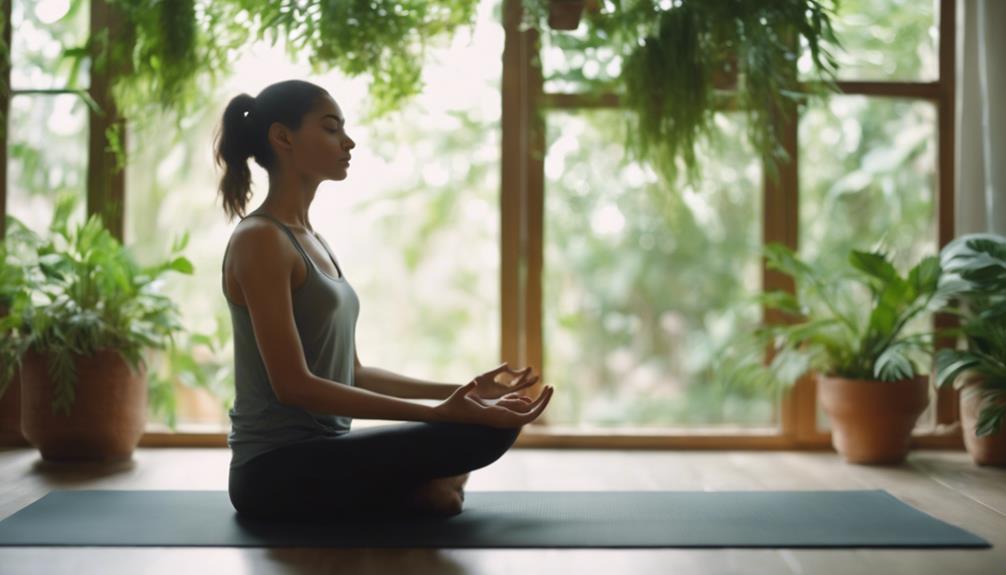
Begin on a transformative journey with 10 purposeful steps to master mindfulness. Discover the power of self-awareness and inner peace. Uncover your why to fuel motivation. Dedicate just 10 minutes daily to enhance focus and reduce stress. Create a serene space to deepen your practice. Tune into your body and manage emotions mindfully. Embrace gratitude and cultivate stillness within. By embracing these steps, you can access the profound benefits of mindfulness. Start your journey to a more mindful life today.
Understanding Mindfulness Practice
Begin on a transformative journey by immersing yourself in the essence of mindfulness practice – a powerful tool for cultivating inner peace and enhancing overall well-being. When you engage in mindfulness, you explore into the domain of self-discovery and inner peace. By focusing on your thoughts, emotions, and sensations without judgment, you start to manage stress more effectively. Mindfulness isn't just a practice; it's a way of life that can lead to a profound improvement in your well-being.
As you explore deeper into mindfulness, you'll notice a remarkable shift in how you perceive and handle stress. Through this practice, you develop the ability to stay present and cultivate self-awareness. This heightened sense of awareness can enhance your concentration and clarity of mind. Additionally, regular mindfulness practice can improve your memory, emotional regulation, and overall mental well-being. Embrace mindfulness as a daily ritual, and witness the positive impact it has on your life.
Importance of Knowing Your Why
Explore the core of mindfulness by revealing the purpose behind your practice, kindling a spark that propels your path towards self-discovery and holistic well-being.
When you focus on breath and investigate clarifying intentions, you reveal a profound understanding of why mindfulness is essential in your life. Understanding your why is like fuel for your mindfulness journey, keeping you motivated and committed. It acts as a guiding light, helping you navigate through the challenges and obstacles that may arise along the way.
By knowing your purpose behind mindfulness, you enhance its effectiveness, making each moment of practice more meaningful and impactful. Your why serves as a compass, directing you towards personal growth and overall well-being.
Making Time for Mindfulness

Uncover the transformative potential of mindfulness by carving out dedicated moments in your day for its practice. Allocating just 10 minutes each day to mindfulness can yield significant benefits, such as improved focus and reduced stress levels.
Research indicates that integrating mindfulness into your daily routines, like taking short breaks or practicing before bed, can enhance your overall well-being. By setting aside specific time for mindfulness, you not only create a regular practice but also foster a sense of inner peace within yourself.
Prioritizing mindfulness in your schedule can lead to better emotional regulation and increased mental clarity throughout the day. Embracing these moments of mindfulness allows you to tap into a profound source of calm and resilience that can positively impact every aspect of your life.
Start small, be consistent, and watch the ripple effects of this practice unfold in your daily experiences.
Finding a Comfortable Space
Create your own oasis of calm by selecting a quiet, clutter-free corner where you can fully immerse yourself in mindfulness.
Set the stage for relaxation with soft lighting, comfortable seating, and soothing elements like plants or candles.
Personalize this space with items that resonate with tranquility, allowing you to cultivate a sense of peace and focus during your mindfulness practice.
Quiet Mindful Corner
Establishing a serene, mindful corner is paramount for nurturing your practice of mindfulness and fostering inner peace. Your quiet space should be free from distractions, allowing you to focus solely on your mindfulness practice. Choose a corner where you feel at ease, away from the hustle and bustle of daily life.
By creating a dedicated area for mindfulness, you signal to your mind that it's time to unwind and be present. Enhance this space with elements like soft cushions, calming candles, or soothing essential oils to elevate the ambiance. Personalize your mindful corner to make it inviting and conducive to deepening your practice.
Serene Environment Setup
To cultivate a serene environment for your mindfulness practice, seek out a tranquil space free of distractions where you can fully immerse yourself in the present moment. Finding a quiet space is essential to allow your mind to focus and your body to relax.
Consider utilizing meditation apps or timers to guide your practice and maintain consistency. Create a comfortable seating arrangement that supports relaxation and helps you stay focused during meditation. Enhance the ambiance of your space with relaxing elements like burning candles or incense.
Setting intentions by writing down areas of focus or release can help you stay mindful throughout your practice. Embrace the stillness of your surroundings to deepen your connection with the present moment.
Being Mindful of Your Body

When you practice mindfulness of your body, you awaken to the present moment through a deep connection with your physical sensations. It's about focusing on each step, engaging in other forms of meditation training to heighten your awareness. Take a moment to tune into your body – notice the subtle movements, the sensations beneath your skin, and the rhythm of your breath. By being fully present in your body, you can reduce stress, increase relaxation, and enhance your overall well-being.
Pay attention to your posture, how you move, and even the environment around you. Mindfulness of the body isn't just about physical sensations; it's about cultivating a deeper understanding of yourself. Try incorporating techniques like body scans and mindful breathing to strengthen the bond between your mind and body. This practice can lead to better self-care habits and a profound sense of embodiment. Embrace the opportunity to nurture a harmonious relationship with your body, for it's the vessel through which you experience the world.
Cultivating Awareness of Thoughts
Awaken your inner observer by gently acknowledging the flow of thoughts passing through your mind without entanglement or judgment. Cultivating awareness of thoughts is a transformative practice that invites you to witness your mental landscape with clarity and non-attachment. As you observe your thoughts mindfully, you begin to recognize recurring patterns and themes that shape your experiences. This heightened awareness allows you to understand how thoughts influence your emotions and actions.
Mindfulness enables you to step back from the constant stream of thoughts, creating space between you and your mental processes. By practicing non-reactivity to your thoughts, you can cultivate a sense of detachment that fosters inner peace and emotional well-being. Embrace the power of mindfulness to sharpen your mental clarity and enhance your ability to navigate life's challenges with grace. Remember, by developing awareness of your thoughts, you pave the way for profound personal growth and self-discovery.
Managing Emotions Mindfully

Discover the power of mindfulness by embracing your emotions with compassion and understanding. Managing emotions mindfully is a practice that can transform the way you navigate through life's ups and downs. By approaching your emotions with awareness and acceptance, you can cultivate emotional intelligence and resilience. Instead of reacting impulsively to anger, sadness, or fear, mindfulness allows you to observe these emotions as temporary experiences, freeing yourself from being defined by them.
When you respond to your emotions with compassion, you create space for growth and healing. Mindfulness teaches you to acknowledge the presence of your emotions without judgment, giving you the clarity to understand their root causes. This process not only fosters inner peace but also enhances your ability to handle life's challenges with grace and poise.
Expanding Your Awareness Practice
As you start on expanding your awareness practice, remember that mindful breathing techniques hold the power to connect you to the present moment.
Cultivating inner stillness through these practices allows for a deeper understanding of your thoughts and emotions.
Embrace this journey with an open heart, for it's in this expansion that true mindfulness blossoms.
Mindful Breathing Techniques
Enhance your mindfulness practice by delving into the transformative power of mindful breathing techniques. Take a moment to focus on your breath, reduce stress, and improve concentration through the following steps:
- Deep Breathing: Inhale deeply through your nose, feel your lungs expand, then exhale slowly through your mouth, releasing tension.
- Counted Breaths: Count each inhale and exhale cycle up to 10, then start again, keeping your mind anchored on the breath.
- Body Scan Technique: As you breathe, scan your body from head to toe, noticing any areas of tension and releasing them with each exhale.
Cultivating Inner Stillness
To truly master mindfulness, one must embrace the practice of cultivating inner stillness, expanding awareness to observe thoughts and emotions without judgment.
Cultivating inner stillness is a journey that involves delving deep into the essence of your being, allowing yourself to connect with the present moment fully.
Through mindfulness and meditation, you can train your mind to focus on the here and now, letting go of distractions and worries.
By regularly practicing techniques like meditation and body scans, you can enhance your ability to remain calm and centered amidst life's chaos.
Developing inner stillness not only improves your focus and clarity but also empowers you to navigate emotions with grace, leading to a profound sense of peace and well-being.
Embracing Gratitude

Embrace gratitude not just for the blessings you receive but for the strength and courage it ignites within you during uncertain times. Here's why gratitude is essential:
- Gratitude Fosters Resilience: When you practice gratitude, you develop the ability to bounce back from hardships with grace and strength.
- Gratitude in Suffering: Acknowledging gratitude amidst suffering can help shift your perspective, allowing you to find moments of beauty and hope even in challenging times.
- Global Cooperation: Recognizing and appreciating the global efforts towards vaccines and social justice initiatives can inspire gratitude for the unity and compassion that exists even in the face of suffering.
Embodying the Mindfulness Practice
Embodying the mindfulness practice is about infusing every moment with awareness, making each action a conscious choice toward presence. By observing your thoughts, emotions, and sensations without judgment, you can cultivate a deeper sense of peace within yourself.
Benefits of Mindfulness
Enhancing your self-awareness through mindfulness practice opens the door to a transformative journey of acceptance and inner peace. Embracing mindfulness brings a multitude of benefits into your life:
- Stress Management: Mindfulness helps you navigate stress by grounding you in the present moment, allowing you to respond to challenges with clarity and composure.
- Cognitive Function Enhancement: Regular mindfulness practice sharpens your concentration, memory, and overall cognitive abilities, empowering you to tackle tasks with heightened efficiency.
- Emotional Regulation and Well-being: By cultivating mindfulness, you develop a deeper understanding of your emotions, fostering greater compassion for yourself and others while nurturing a profound sense of inner peace.
These benefits highlight the transformative power of mindfulness in enhancing your overall well-being.
Daily Mindfulness Practices
Integrating mindfulness into your daily activities enhances your awareness and presence, fostering a deeper connection with the present moment.
Engage in mindful eating by savoring each bite, noticing flavors, textures, and the nourishment it provides your body.
Try walking meditation, focusing on each step, feeling the ground beneath you, and the movement of your body.
Cultivate awareness by actively listening to others without judgment or distraction.
Use cues like a bell chime or phone notification to remind yourself to pause, breathe, and come back to the present throughout your day.
Embrace these practices in your routines to experience greater clarity, peace, and emotional balance.
Mindfulness isn't just a practice; it's a way of living fully.
Mindful Living Tips
Immerse yourself fully in the present moment, letting go of distractions and embracing the richness of each experience. To enhance your mindful living journey, consider the following tips:
- Cultivate Awareness: Practice mindfulness by being fully present in all you do, from eating to interacting with others.
- Explore Meditation Techniques: Experiment with different forms of meditation like loving-kindness and walking meditations to deepen your practice.
- Embrace Heart-Centered Practices: Develop trust, openness, and compassion towards yourself and others, as they're essential for walking the spiritual path.
Frequently Asked Questions
How Long Does It Take to Master Mindfulness?
Mastering mindfulness is a personal journey with no set timeline. Consistent practice over weeks can lead to tangible changes in brain functions linked to memory and emotions.
Remember, progress varies for each individual. By devoting daily time to mindfulness techniques, you can enhance awareness, presence, and emotional control.
Embrace the process, enjoy the benefits, and let mindfulness become a valuable part of your daily life.
How Do You Master Mindfulness?
To master mindfulness, you center your focus on the present moment, embracing awareness and peace. You practice mindful breathing, grounding yourself in the now.
Meditation becomes your sanctuary, a place to reflect and let go of distractions. Embrace gratitude and kindness, nurturing your spirit.
Through dedication and consistency, you'll cultivate a deep connection with yourself and the world. Celebrate each small victory along your journey to mastering mindfulness.
Can You Overdo Mindfulness?
You can definitely overdo mindfulness if you push yourself too hard. Remember, balance is key. Aim for gentleness and self-compassion in your practice. Avoid getting caught up in perfectionism. By finding that harmonious middle ground, you'll truly benefit from mindfulness without adding unnecessary stress.
Embrace imperfection and allow yourself to grow at your own pace. It's not a race; it's a journey towards inner peace and well-being.
What Are the 10 Steps to Meditation?
Start your meditation journey with ten powerful steps that lead to inner peace.
Embrace awareness, reflect on your thoughts, and practice mindfulness in every moment.
Dive deep into meditation practices that reduce stress, boost focus, and enhance emotional well-being.
Cultivate compassion through loving-kindness meditation, fostering positivity within yourself and towards others.
Your path to mindfulness is illuminated by these transformative steps towards a more mindful and fulfilling life.
Conclusion
Congratulations on taking the first steps towards mastering mindfulness! Remember, it's not about perfection, but progress. Keep practicing, stay consistent, and embrace the journey of self-discovery.
Can you imagine the positive impact mindfulness can have on your life? Keep asking yourself, 'How can I bring more mindfulness into my daily routine?' The answer lies within you.
Keep shining bright on this mindful path!

